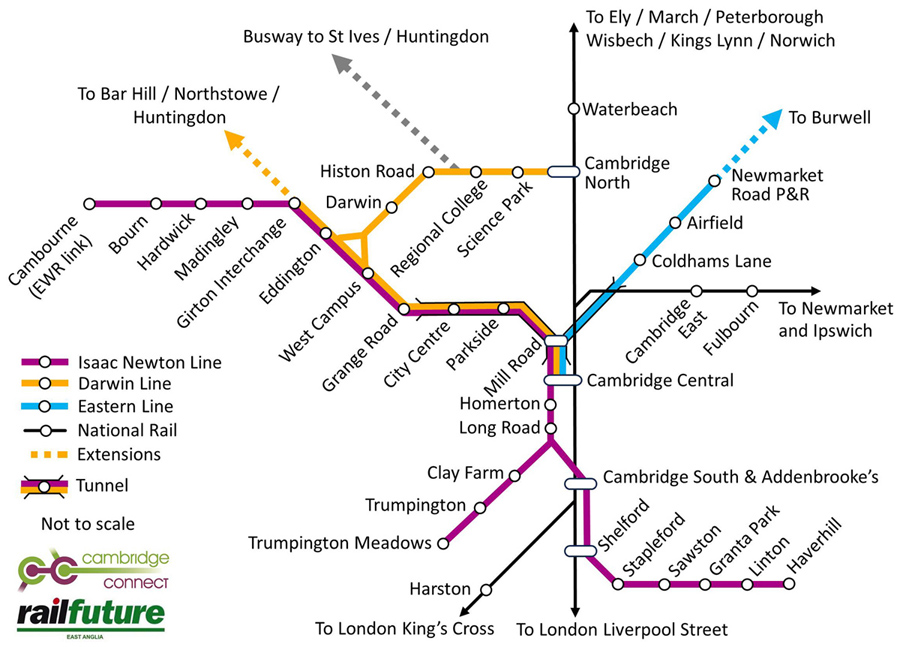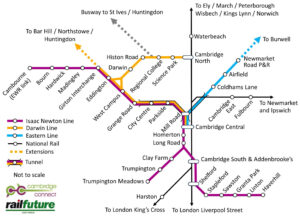Cambridge Connect and Railfuture East Anglia collaborated closely over 2020 / 2021 to make a radical update to the original Cambridge Light Rail proposals, first advanced in 2016. We have worked with a range of partners to develop this new vision, including Amey, Ankura, CMS, UK Tram and individuals who were responsible for delivery of the Docklands Light Railway and major extensions to Manchester Metrolink, as well as local residents with detailed knowledge of Cambridge and its surrounding region.
Our focus has been on cost-effectiveness, practical deliverability, and reduction of risk. To meet these goals we re-designed the light rail network to reduce substantially the amount of tunnelling needed in the historic city centre, and also the overall length of the network. By reducing tunnel length to ~4 km (half the length originally proposed), and eliminating two underground stations, we are able to achieve major reductions in cost.
Two principal lines – Isaac Newton Line / Darwin Line
The ‘Isaac Newton Line’ would be the backbone of Cambridge Light Rail. Eventually, this would extend from Cambourne in the northwest to Haverhill in the southeast, via a short tunnel in the Cambridge city centre. The ‘Darwin Line‘ would extend overground from Cambridge North rail station to the Science Park and University West Campus, share the Isaac Newton Line through the city to the Central Rail Station, then branch to Trumpington. We propose extensions to east Cambridge (serving housing developments), Bar Hill, Burwell, and perhaps Huntingdon. For the present, however, more remote destinations would be served by connecting bus services. Mass transit is most cost-effectively delivered as a specialised, fit-for-purpose, service that can connect with other modes to serve wider destinations. For example, remote villages can be served by connecting bus services, and regional / national cities can be reached on the heavy rail network or coach services. In our view, this is the most flexible and realistic approach to deliver the public transport services that can successfully drive modal shift.
Integration with heavy rail
Literally billions have been invested in the heavy rail network over many decades. It makes sense to leverage this investment to its maximum potential by partnering the heavy rail network with light rail for “last-mile” connections. New stations have been added (eg. Cambridge North, Soham), and Cambridge South is currently being built. A connection to Wisbech is under evaluation. Our plan aims fully to utilise heavy rail lines and services where appropriate, and eliminate potential duplication. For example, we suggest Waterbeach could be served by heavy rail and local bus services rather than build a new potentially duplicative service – at least until evidence of need is apparent. We also propose that Fulbourn could be served by stops on the heavy rail line, shown as “Cambridge East” and “Fulbourn” on our maps. Cambridge Light Rail would interface with heavy rail services at many points (eg. Cambridge Central, Cambridge North, Cambridge South, Shelford and Cambourne (when East-West Rail comes forward). We think a light rail line to Cambourne – co-aligned with the A428 – would in due course complement East-West Rail by enabling travellers easy access from Cambourne to the west side of Cambridge and the Science Park.
Phased delivery
Delivery of both the Isaac Newton Line and the Darwin Line would be in several phases.
Phase One on the Isaac Newton Line would extend from the Eddington / Girton Interchange in the northwest, via the University West Campus, the historic City Centre, the Cambridge Central Rail Station, continuing through to Addenbrookes and the Biomedical Campus. The second phase would extend to Great Shelford, and Sawston to Granta Park in the southeast. The short city tunnel needed to enable this line would be built in Phase One. The link to Trumpington would also be built in Phase One.
The rationale for these delivery priorities is that it serves the highest demand. A functional core line to meet the highest demand at the start of the scheme will return significant revenue from Day One of opening. To build the extensions first without the city tunnel in place is like having tails wagging with no dog. You first need a happy dog before the tails can wag.
Phase Two of the Isaac Newton Line would link the Girton Interchange to Cambourne. Phase Two of the Darwin Line will link the West Campus to the Science Park, creating a fully integrated network across the region.
Phase Three proposes several extensions, to Haverhill, Bar Hill, Northstowe and Burwell, all of which can be timed and brought forward as demand and financing allows. We also see potential for conversion of the northern busway to light rail, extending to Huntingdon. This long-term strategic vision is pragmatic in terms of scope and scale. Having set out a long-term spatial strategy, practical delivery needs to be in accordance with affordability and demand. Manchester took ~40 years to deliver a network of ~100 km.
Extensions to St Neots and Huntingdon, and perhaps other destinations, could be made, but in the interim the most cost-effective way in which to serve these more remote destinations is by connecting bus services, an approach that works well in European cities.
Need for the tunnel
The tunnel we propose is confined to the minimum practical length in the historic city core, and would be 4 km in length. Segregated surface-running routes will run elsewhere. We have focused on the essential needs, and that is to overcome practical and heritage constraints in the Cambridge city core.
Our tunnel is simple and practical – a single, bi-directional, tunnel of 4 km with three portals. The Middle Portal would be near the Cambridge Central rail station, where space is available on the present car park. Other options in this area are also possible. The West Portal would be near Grange Road, with the precise location yet to be decided. The East Portal would be near Coldhams Lane, enabling extension to serve the housing coming forward on the Marshall site.
We recognise that even a short, simple tunnel is expensive, although the many constraints in the historic core make a tunnel a necessity for any mass-transit system if it is to serve the inner city. This has – in fact – already been recognised by both the Cambridgeshire & Peterborough Combined Authority and the Greater Cambridge Partnership (GCP), who agreed that a tunnel in some form was necessary for the CAM project. There are good, practical reasons for this, not least the protection of the important historic setting of Cambridge, maintaining and enhancing the quality of the urban realm, and the need for the mass transit system to cross the River Cam without imposing major environmental impacts. The tunnel overcomes these constraints. While tunnelling is expensive, the costs of not tunnelling are – in our view – also worth considering. Our model is a cost-effective solution that overcomes constraints using the minimum of tunnel necessary: this is affordable when considered in the context of the benefits over time.
Given the investment required, it is vital that any tunnel, however long, is built of a diameter and capacity that is future-proofed. It would be a false economy to build small, narrow tunnels that are highly constrained in their capacity. The COVID pandemic underscored the risks that attend forms of public transport that are under-sized and tightly constrained – for example narrow, low-height buses, or mini-pods. Moreover, standard, well-proven tunnelling technologies implemented elsewhere are needed, not bespoke approaches. A focus on standard, simple, proven approaches will keep costs down will help to ensure the scheme is affordable and deliverable.
We should recognise that the tunnel not only brings transport benefits, enabling ease of connections, speed and reliability of service. There are huge benefits to be realised by boosting inner city vitality, increasing its attractiveness. One of the main benefits however, is that the tunnel would enable much more extensive pedestrianisation within the city centre while still maintaining excellent inner city access. We therefore envisage major improvements to the inner city urban realm through the investment in the tunnel. The tunnel will also provide an exceptional link in support of tourists arriving in Cambridge by train. A fast and frequent service from the train station to the historic core will attract substantial patronage, which will in turn help to pay for the scheme.
Summary
Cambridge Connect and Railfuture East Anglia propose two main lines delivered in two main phases for Cambridge Light Rail development, which could be implemented singly or in combination:
- PHASE ONE – ISAAC NEWTON LINE (2025-30): Girton Interchange / Eddington to Addenbrookes, connecting the three main University campuses, the City Centre and Addenbrookes. The short tunnel is part of Phase One.
- PHASE ONE – DARWIN LINE (2025-30): Addenbrookes to Trumpington (convert busway to light rail).
- PHASE TWO – ISAAC NEWTON LINE (2028-32): Girton Interchange to Cambourne; Addenbrookes to Granta Park.
- PHASE TWO – DARWIN LINE / EASTERN LINE (2028-32): West Campus to Science Park; Cambridge Station to Marshall Airfield housing site.
- PHASE THREE (TBD): Granta Park to Haverhill; Bar Hill; Northstowe; Burwell.
- FUTURE (TBD): St Neots, Huntingdon, Wisbech and other destinations as demand / finance dictates.









